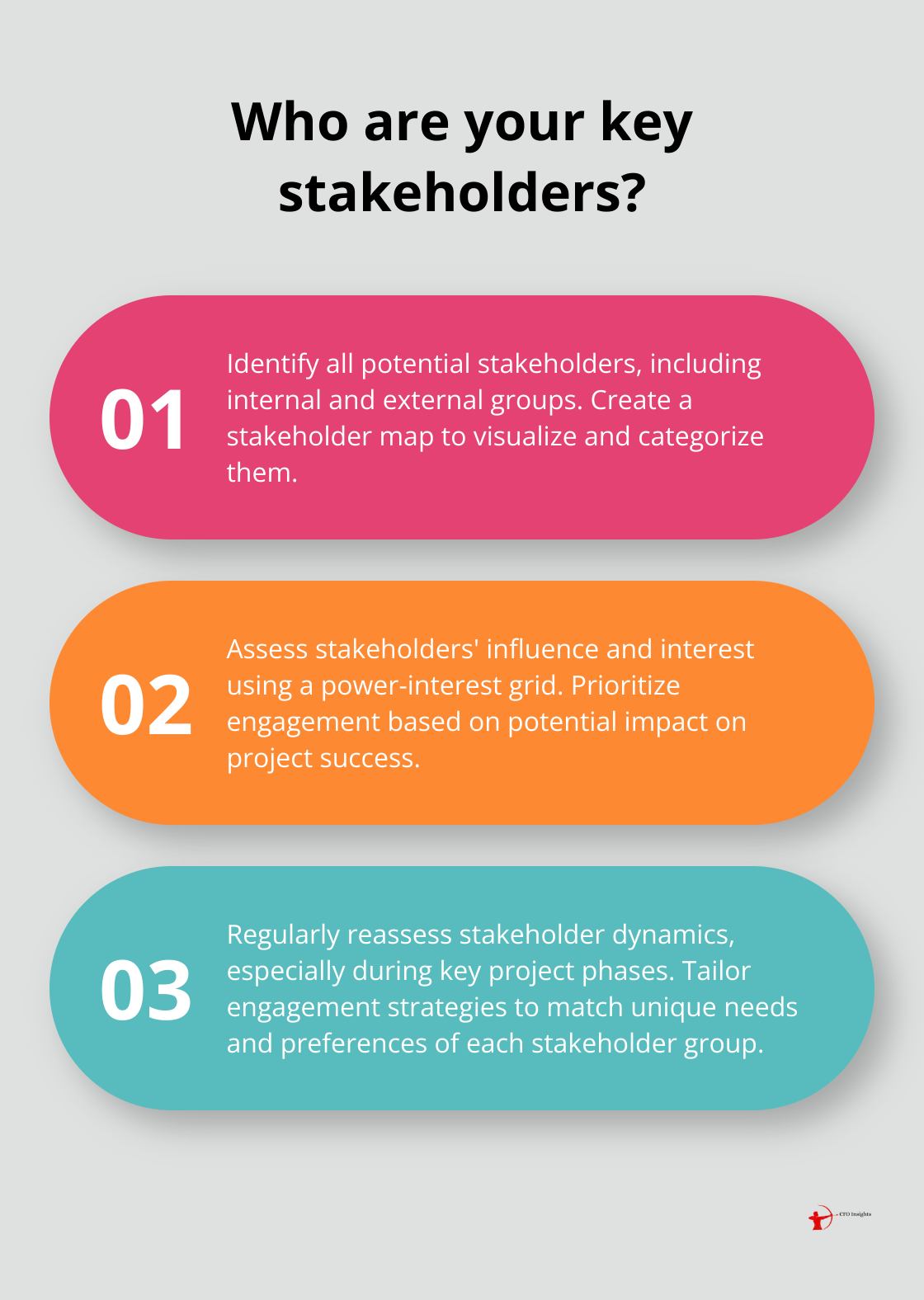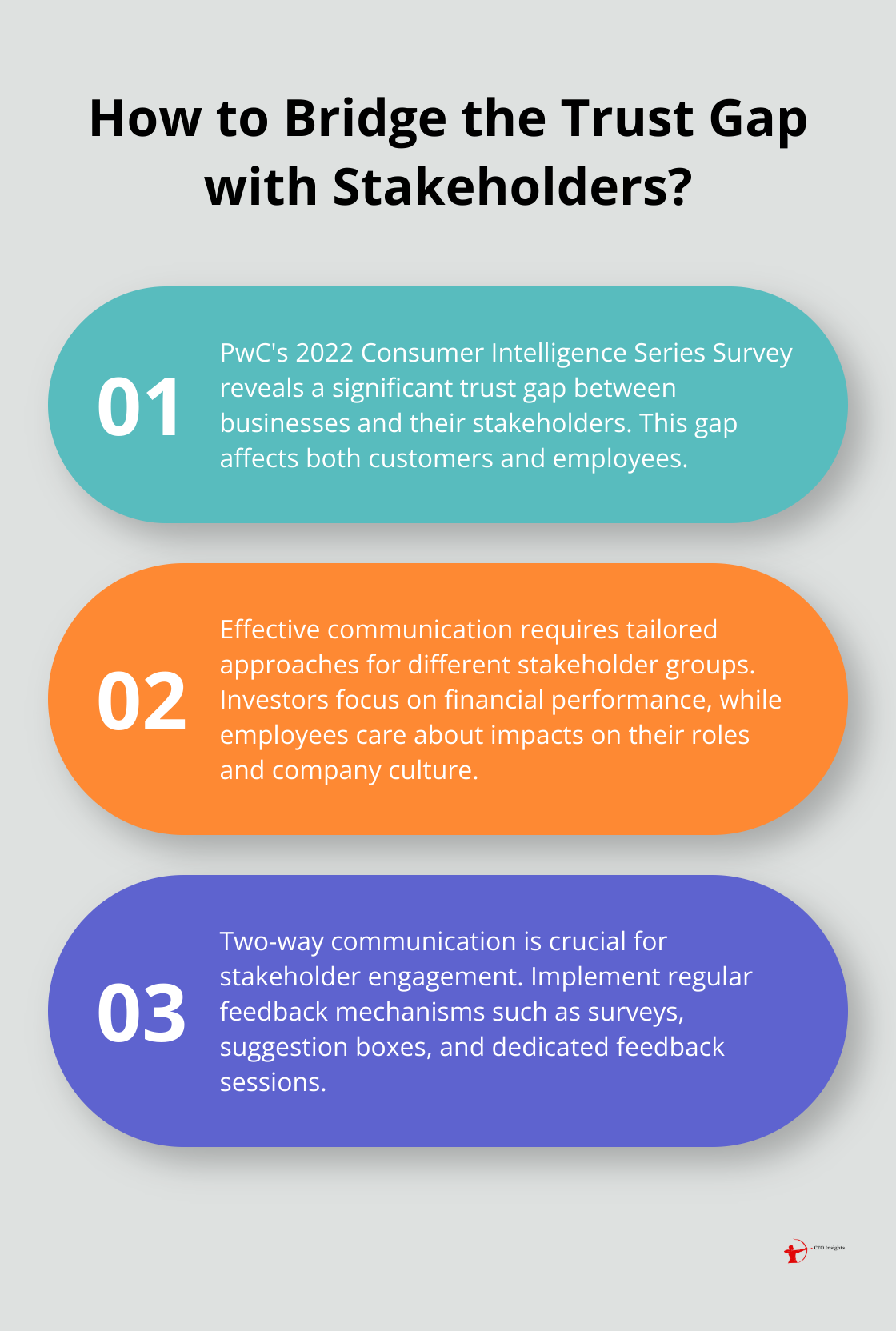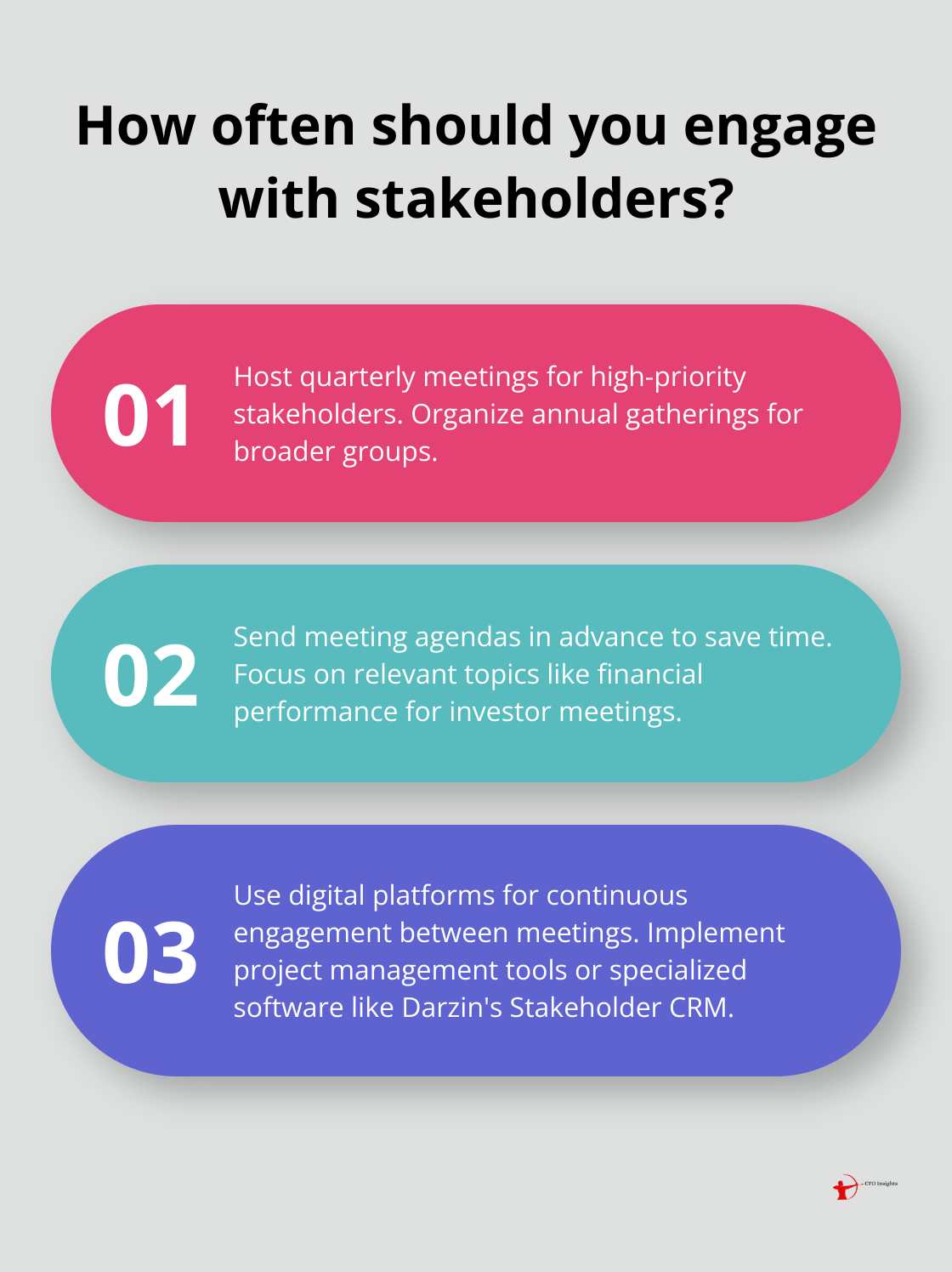At CFO Insights, we know that good stakeholder engagement is vital for business success. A well-designed strategy can transform relationships, boost project outcomes, and drive organizational growth.
In this post, we’ll explore how to create a winning stakeholder engagement approach. From identifying key players to implementing effective tactics, we’ll provide practical steps to enhance your engagement efforts.
Who Are Your Key Stakeholders?
Mapping Your Stakeholder Landscape
The first step in creating a winning stakeholder engagement strategy is to identify all potential stakeholders. List everyone who might affect or be affected by your project or organization. This includes internal stakeholders (employees, board members) and external ones (customers, suppliers, investors, regulatory bodies).

Create a stakeholder map to visualize your stakeholder landscape. Divide stakeholders into categories such as decision-makers, influencers, and those directly impacted by your actions. This visual representation helps you see the big picture and ensures you don’t overlook any important groups.
Assessing Influence and Interest
After identifying your stakeholders, you must understand their level of influence and interest. Use a power-interest grid to plot each stakeholder on a matrix. One axis represents their power or influence, while the other shows their interest in your project.
Prioritizing for Maximum Impact
Not all stakeholders require equal engagement. Prioritize based on their potential impact on your project’s success. Focus your efforts on those with high influence and high interest first.
Don’t neglect those with high influence but low current interest. These stakeholders could become crucial allies if their interest increases. Develop strategies to keep them informed and potentially increase their engagement over time.
Adapting to Changing Dynamics
Stakeholder dynamics can shift over time. Regularly reassess your stakeholder landscape, especially during key project phases or when significant changes occur in your business environment.
Tailoring Your Approach
Each stakeholder group has unique needs and preferences. Try to customize your engagement strategies to match these differences. This personalized approach (which we at CFO Insights have found to be highly effective) ensures that your communication resonates with each stakeholder group.
A thorough understanding of your key stakeholders sets the stage for targeted, effective engagement strategies. This foundational work directs your subsequent communication and engagement efforts for maximum impact. As we move forward, we’ll explore how to develop effective communication channels that cater to your diverse stakeholder groups.
How to Communicate Effectively with Stakeholders
Select the Right Communication Channels
Effective stakeholder communication starts with choosing appropriate channels for each group. High-priority stakeholders benefit from a mix of personal and digital methods. Face-to-face meetings or video calls build stronger relationships, while email updates keep stakeholders informed between meetings.

For larger stakeholder groups, digital platforms like project management tools or dedicated stakeholder engagement software prove useful. These tools help manage communications, track engagement, and gather feedback efficiently.
Craft Targeted Messages
Stakeholder communication requires tailored approaches. Each group has unique interests and concerns that need addressing. Create a messaging matrix that outlines key points for each stakeholder group.
When communicating with investors, focus on financial performance and growth projections. For employees, emphasize how projects will impact their roles and company culture. Customers often show more interest in how changes will improve products or services.
Build Two-Way Communication
Effective stakeholder engagement creates dialogue, not just information dissemination. Implement regular feedback mechanisms such as surveys, suggestion boxes, or dedicated feedback sessions.
PwC’s 2022 Consumer Intelligence Series Survey on Trust shows a jarring gap in trust between businesses and their customers and employees.
To address this gap, set up structured feedback loops. This could involve quarterly review meetings with key stakeholders, monthly pulse surveys, or even a stakeholder advisory board for major projects.
Leverage Technology for Engagement
Technology significantly enhances stakeholder communication in today’s digital age. Leverage Technology for Engagement with tools such as CRMs, relationship management software, feedback tools, and engagement platforms.
The goal is to make communication as seamless and accessible as possible for your stakeholders. Choose user-friendly tools that align with your stakeholders’ preferences.
As we move forward, we’ll explore how to implement these communication strategies through specific stakeholder engagement tactics. These tactics will help you put your communication plan into action and create meaningful interactions with your stakeholders.
How to Put Your Engagement Strategy into Action
Host Impactful Stakeholder Meetings
Regular stakeholder meetings form the backbone of effective engagement. We recommend quarterly meetings for high-priority stakeholders and annual gatherings for broader groups. You should send a meeting agenda to your stakeholders in advance. Everyone can then ask questions or raise concerns beforehand, saving valuable time during the meeting.

For example, when you host a meeting with investors, focus on financial performance, growth projections, and strategic initiatives. Prepare detailed presentations and allow ample time for Q&A sessions. This approach helps build trust and transparency with investors.
Use Digital Platforms for Continuous Engagement
Between meetings, maintain engagement through digital platforms. Project management tools (like Asana or Trello) can keep stakeholders updated on project progress. For more comprehensive stakeholder management, consider specialized software.
Darzin’s Stakeholder CRM allows your business to map, track, and communicate with all its key stakeholders in one centralized platform. It helps manage stakeholder information and engagement activities.
These platforms allow you to:
- Share regular updates
- Collect feedback
- Track engagement metrics
- Manage stakeholder information
Gather In-Depth Insights through Surveys and Focus Groups
Surveys and focus groups provide valuable, detailed feedback from your stakeholders. We recommend annual comprehensive surveys and quarterly pulse checks.
When you design surveys, keep them concise (ideally under 10 minutes to complete) and focused on specific topics. Use a mix of multiple-choice and open-ended questions to gather both quantitative and qualitative data.
For focus groups, try to include 6-8 participants per session. This size allows for diverse perspectives while ensuring everyone has a chance to contribute. Consider using professional moderators to guide discussions and extract meaningful insights.
Foster Collaborative Decision-Making
Involve stakeholders in decision-making processes to boost engagement and buy-in. Create opportunities for stakeholders to contribute to important decisions that affect them.
One effective method is the Delphi Process, which brings together diverse stakeholders to reach consensus. This approach helps reach consensus on complex issues while minimizing groupthink.
Another strategy involves establishing stakeholder advisory boards for major projects or initiatives. These boards can provide valuable input and act as a bridge between your organization and broader stakeholder groups.
Final Thoughts
Good stakeholder engagement forms the cornerstone of successful business strategies. It requires thorough stakeholder identification, effective communication, and targeted engagement tactics. Organizations must map their stakeholder landscape, assess influence and interest, and prioritize key players to set the stage for meaningful interactions.

Effective communication channels and targeted messages ensure engagement efforts resonate with each stakeholder group. Regular meetings, digital platforms, surveys, and collaborative decision-making processes bring the strategy to life. These methods foster two-way dialogue, gather valuable insights, and build trust with stakeholders.
Successful stakeholder engagement leads to improved decision-making, reduced risks, and increased support for initiatives. We at CFO Insights understand the critical role that effective stakeholder engagement plays in financial management and organizational growth. Our fractional CFO services can help you develop robust stakeholder engagement strategies that align with your financial goals and support your business objectives.




